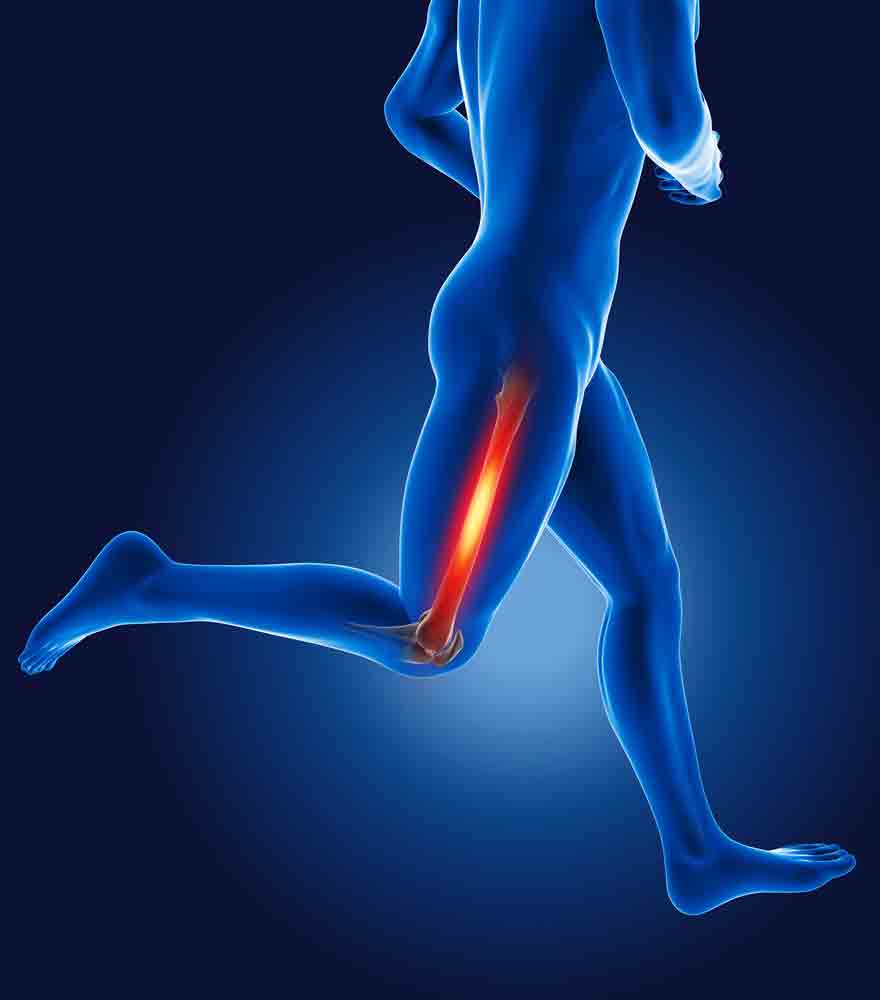Of all of the injuries that can beset runners, the iliotibial band friction syndrome (ITBFS) is by far one of the most common and frustrating. A typical scenario for ITBFS is in a relatively novice athlete who, just when they are really getting accustomed to training on a regular basis, begins to experience lateral knee pain during a run. The pain becomes severe and forces cessation of the activity. By the next day the pain is gone. However, each time that the athlete tries to run again, the pain returns. Discouraged and downtrodden, the athlete is liable to give up. And in too many cases, this is exactly what happens. Fortunately though, with a little bit of insight and preventative steps, ITBS can be an experience that not everyone needs to have. Better yet, when ITBS does become a problem, there are solutions.
This post will cover the anatomy of the ITB, several of the proposed theories behind why ITBFS develops, measures that can be undertaken to prevent it in the first place and treatment options once the problem has taken root.
The IT Band
The iliotibial band (ITB) is a dense, fibrous band originating from the pelvic bone and passing down the outer third of the thigh. At the level of the hip, muscle fibers from the gluteus maximus (GM) and Tensor fascia lata (TFL) merge with the ITB. As the ITB continues down the outside of the leg and approaches the knee joint, it passes over a protuberance on the outer aspect of the femur (thigh bone), the lateral femoral epicondyle (LFE). A thin layer of fatty tissue is located between the ITT and LFE.
The IT Band Friction Syndrome
The ITBFS afflicts runners most commonly, though cyclists may experience it as well. The main symptom of ITBFS is a sharp pain on the outer aspect of the knee that can radiate into the outer thigh or calf. While pain is localized along the lateral knee, it also can include the hip. Pain is worse with downhill running, becomes worse with activity after a pain-free start and is more pronounced shortly after the foot contacts the ground surface. Most individuals experience pain only during activities; however, pain with walking is common as the syndrome progresses.
The most commonly accepted theory of how ITBFS develops posits that the ITB slides back and forth over the LFE as the knee is bent beyond a certain point (about 20 degrees) and then straightened again. Various biomechanical factors are hypothesized to increase this friction, including weak hip abductors (the muscles responsible for pulling the legs apart), a tight ITB, the angle of the knee and the way in which the foot strikes the ground.
Prevention
Preventing ITBFS is preferable to treating it once it is established. Fortunately, by following some simple preventative measures, it is possible to have a healthy running career without ever having to deal with ITBFS.
Proper footwear
Wearing proper, supportive running shoes, changed at regular intervals. A running shoe loses about 50 percent of its shock absorptive capacity after around 300 miles. Keeping shoes for too long increases the risk of ITBFS and other injuries.
Strengthen the hip abductors
Incorporating specific strengthening exercises for the gluteals can be an important preventative measure.
Increase running volume and pace in a measured fashion
Doing too much too soon is a sure way to incur running injuries including ITBFS. Volume should increase no more than 5-10 percent per week and longer runs should be done at slower pace than shorter runs.
Choice of running surface
Running on concrete or cambered surfaces increases the likelihood of ITBFS. These should be avoided.
Treatment
The treatment of ITBFS may be thought of as happening in two stages: acute and chronic.
The acute stage of therapy is aimed at reducing the inflammation in and around the ITB. This will reduce pain and any associated swelling. Non-steroidal anti-inflammatory drugs (NSAIDs) such as ibuprofen and naproxen are very useful in this regard. These drugs should be avoided by those with a history of kidney issues or peptic ulcers but otherwise are considered quite safe. The application of ice to the affected area may also provide some anti-inflammatory effects and provide symptom relief. The final element of the acute phase is a complete cessation of running until such time as the activity may be undertaken without pain (usually one to two weeks).
The chronic phase of treatment is aimed at alleviating those factors that led to the problem in the first place. This includes all of the preventative measures listed above. In addition, attempts can be made at stretching the IT band at the level of the Tensor fascia lata at the level of the hip—the one place where the IT Band is amenable to lengthening.
An example of a specific stretch for this purpose is described here:
- Standing upright, cross the right foot in front of the left foot.
- Bend forward at the hips as far as is comfortable.
- Reach with both arms to the right and thrust the hips out to the left.
- You should feel a stretch over the left hip if you are doing this correctly.
- Reverse legs and directions to stretch TFL on the right.
In almost all case, ITBFS is self limited and no more than a painful nuisance. Left untreated though, ITBFS may become chronic and more severe eventually impacting daily activities. In the worst cases, surgery may become an option with excision of the bursal sac that overlies the LFE under the ITB. This treatment is reserved for the most severe cases though, thankfully encountered only very rarely.

